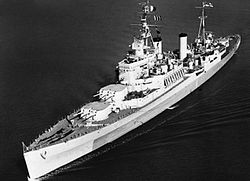HMS Uganda (C66)
|
||||||||||||||||||
|
||||||||||||||||||
|
||||||||||||||||||
|
||||||||||||||||||
The HMS Uganda (C66) was a cruiser of the Crown Colony-class cruiser , the first by the British Royal Navy later by the Canadian Royal Canadian Navy as HMCS Uganda was operated and finally in HMCS Quebec was renamed.
The Uganda in 1943 during the Second World War, provided by the Royal Navy in service. After the ship had completed test and training runs in Scapa Flow by March 1943 , it made its first two missions as an escort ship in a convoy to Sierra Leone . The next mission was an escort for the Queen Mary across the Atlantic, which Winston Churchill carried to Washington . At Argentia off Newfoundland , the fuel ran out and the ship broke off the escort. Then Uganda returned to Plymouth for an overhaul .
Then she took in the Mediterranean at the Operation Husky , the invasion of Sicily and the Operation Avalanche in part, the invasion of the Italian mainland. There, on September 13, she was hit by a steerable 1.4-ton Fritz X glide bomb of the type Fritz X on the starboard stern off Salerno, which had been dropped by a machine from Kampfgeschwader 100 . The bomb penetrated seven decks and the hull before exploding, killing 16 crew members and wounding seven others. The ship was towed by the Narragansett to Malta , where it was poorly repaired. Since no dry dock with appropriate repair facilities for a full repair was available nearby, the ship was sent to the port of the Charleston Naval Base in South Carolina , which it reached on November 27, 1943. During the repair, the ship was ceded by the British to the Canadian Navy.
Under Canadian leadership, the catapult for the launch of Supermarine Walrus reconnaissance aircraft was dismantled and replaced by recreation rooms for the crew and a modern radar . The ship was put back into service on October 21, 1944 and was now probably the most modern ship in the Royal Canadian Navy and was provided with a crew of selected officers. Rollo Mainguy , who later became Chief of Naval Staff, became the captain . One of the officers was John Robarts , who later became Prime Minister of Ontario .
The Uganda was on 31 October 1944 by Halifax sent out into the Pacific Ocean, the south to the British fleet sakishima islands to support. She drove via the Suez Canal to Fremantle in Australia , where the 4th Cruiser Squadron was stationed. She was the only Canadian ship to take part in the battle against the Imperial Japanese Navy .
Because of William Lyon Mackenzie King's election promise in the Canadian Prime Minister election that only volunteers would take part in the war against Japan, a vote was held in Uganda on May 7th . The result was that two thirds of the crew refused to continue the mission. The British, angry about this news, demanded that the ship continue its service at least until July 27th. The Canadians in turn offered the Prince Robert as a replacement, but Uganda was eventually replaced by the Argonaut on July 27th . The ship returned to Esquimalt , British Columbia shortly before the end of the war .
HMCS Quebec
On August 1, 1947, Uganda was transferred to reserve status. Due to the Korean War , it was put back into service as Quebec on January 14, 1952 . She was stationed on Canada's east coast. In 1953 it became the flagship of Rear Admiral Abel T. Bidwell , who led a group of Canadian ships to the naval parade in Spithead for Queen Elizabeth II's coronation celebrations . The ship made two more supply trips to Korea before it was finally decommissioned in 1956.
Footnotes
- ^ Jürgen Rohwer , Gerhard Hümmelchen : Chronicle of the naval war 1939-1945. September 1942 , accessed July 14, 2013
